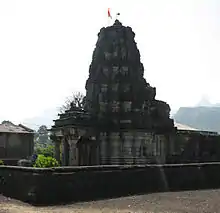Hemadpanti architecture
Hemadpanti Sculpture (Many times spelled as Hemadpanthi) is an architectural style, named after its founder, the prime minister Hemadpant (1259-1274 CE) from the court of Seuna Yadavas of Devagiri.

Amruteshwar temple, Ratangad- an example of Hemadpanthi architecture
Architectural elements
This building style was formed during the 13th Century in Maharashtra, and incorporated black stone and lime, which were readily available and also got the world hertige site.
Notable examples
- Gondeshwar temple, Sinnar.
- Hemadpanti Mahadev Temple sakegaon, Ta.Chikhli Dist. Buldhana.
- Markanda Mahadev, Chamorshi
- Tulja Bhavani
- Bhagwant Temple,Barshi
- Aundha Nagnath Temple
- Vitthal Temple, Pandharpur - but little early work remains. There is also a small temple of Shri. Vitthal, which is as old as the main Vitthal Mandir, in Isbavi area of Pandharpur known as Wakhari Va Korti Devalayas and also known as Visava mandir.
- Palasnath Mandir, Indapur, Pune, now partially submerged in back waters
- Bhimashankar Mandir
- Nagra Temple, Gondia
- Yamai Mandir, Mahalung, near Akluj
- Narsimha Mandir, Partur, near Aurangabad
- Shri Mallikarjun Mandir, Achaler
- Mankeshwar temple, Zodage, Tal. Malegaon, Dist. Nashik, Maharashtra, India.
This article is issued from Wikipedia. The text is licensed under Creative Commons - Attribution - Sharealike. Additional terms may apply for the media files.